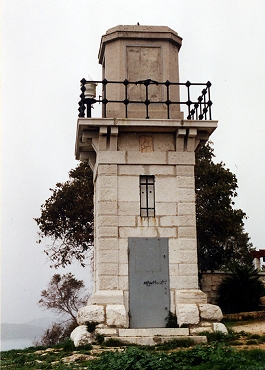Language  |
Beauty & a key
to knowledge |
-
- Wikipedia article
text
text
text
text
A chance encounter
One day I was listening to a CD and one track featured a Croatian singer called Tamara Obrovac. I very quickly realized that she was not singing in Croatian, which is a Slavonic language. At first I thought it was Portuguese, but after a while I decided that it was not. It was clearly a Romance language, but it did not sound at all like Italian – Croatia is not far from Italy. So I wondered if it might be one of the minority languages spoken in Istria and I researched the singer. I learnt that she came from Pula in southern Istria and I also discovered that the words she was singing had forms found in the Istriot language. The song is called Tuca' La Louna (Touch the Moon) and is included in a compilation of songs issued by Putumayo.[1]
Pula, or Pola, is an ancient city which was important in Roman times and is associated with Cassius, one of Julius Caesar's assassins. A large amphiteatre, the Pula Arena, built in the first century AD, survives in a good state of preservation. The city itself is mainly Croatian-speaking, but in nearby areas there are still some hundreds of speakers of Istriot.
Where does Istriot fit in?
The Istriot language is quite distinct from Istro-Romanian, which is spoken in a different part of Istria by people descended from immigrants who probably came from Transylvania in medieval times. In contrast, Istriot appears to have developed in Istria itself from the Latin speech introduced at the time of the Roman Empire. Linguists do not agree on how to classify it. Some regard it as the last surviving form of the Dalmatian language, which was once spoken in a large part of the area on the eastern coast of the Adriatic, but is usually described as becoming extinct in 1898 with the death of the last person who had knowledge of the dialect of the island of Veglia (now Krk).[2] Others prefer to regard it as more closely related to the Rhaeto-Romance languages, while yet others suggest that it is an independent Northern Italian language distinct from both Venetian and Gallo-Italian. The various theories are discussed in the Wikipedia article. Personally, I like to see it as part of a language continuum which included the Rhaeto-Romance languages and Dalmatian, but has now become fragmented. However, it is difficult to unravel the influences of the numerous neighbouring languages and I suspect that the controversy will continue.
What does Istriot look and sound like?
There are two features of the language which leap out of the page:
-
Diphthongization of e → ei and u → ou.
-
Plurals in -i and -e, as in Venetian and Dalmatian, rather than in -s, as in Rhaeto-Romance.
These features can be seen in the poem shown below. It was written in his native Rovigno dialect by the fisherman-poet Ligio Zanini (1927–1993) and is called Griebani (Rocks). The diphthongs stand out, because a circumflex accent (^) has been placed on the second element.
Istriot
La nostra zì oûna longa cal da griebani:
i spironi da Monto inda uò salvà,
e 'l brasso da Vistro uò rastà scuio
pei grutoni pioûn alti del mar,
ca ruzaghia sta tiera viecia-stara.
Da senpro i signemo pissi sensa nom,
ca da sui sa prucoûra 'l bucon
par guodi la veîta leîbara del cucal,
pastadi dala piova da Punente a da Livante
e cume i uleîi mai incalmadi.
Fra ste carme zì stà la nostra salvissa,
cume i riboni a sa salva dal dulfeîn
fra i scagni del sico da San Damian;
el nostro pan, nato gra li gruote, zi stà inbinideî
cul sudur sula iera zbruventa da Paloû...
e i vemo caminà par oûna longa cal da griebani,
c'ancui la riesta lissada dali nostre urme.
Italian
La nostra è una lunga strada irta di sassi:
gli speroni di Monto ci hanno salvato,
ed il braccio di Vistro è rimasto scoglio
per le grotte poste più in alto del mare,
che erode questa antica terra.
Da sempre siamo pesciolini
che da soli si procurano il boccone
per godere la libera vita del gabbiano,
oppressi dalla pioggia di Ponente e di Levante
come olivi senza innesti.
Fra queste insenature è stata la nostra salvezza,
come i pagelli si salvano dal delfino
fra le tane della secca di San Damiano;
il nostro pane, nato tra le grotte, è stato benedetto
col sudore nell'aia ribollente di Palù...
ed abbiamo camminato per una lunga strada dissestata,
che oggi rimane spianate dai nostri passi.
text
The poem and the Italian translation are borrowed from the article in English Wikipedia. Below I give my attempt at a translation, based on two largely impenetrable Google translations – the system does not deal well with poetic imagery – supplemented by much reference to an Italian dictionary and research online.
English
Ours is a long road full of rocks:
the spurs of Monto[3] saved us,
and Vistro's[3] arm remained firm
by the caves above the sea,
which erodes this ancient land.
We have always been small fish
which find their food alone
to enjoy the free life of the seagull,
oppressed by the rain of the West Wind and the East Wind
like olive trees without grafts.
Among these creeks has been our salvation,
as the pandoras[4] shelter from the dolphin
among the recesses of the San Damiano shallows;[3]
our bread, born in the caves, has been blessed
with sweat in the seething threshing floor of Palù[3]...
and we have walked a long, uneven road,
which today is worn smooth by our steps.
Lanterna da Monto  |
| Lighthouse at Rovigno[5] |
text
text
text
text
text
text
text
text
text
text
text
text
text
text
text
text
text
text
text
text
As for the sound of the language, you could listen to Tamara's recording, which is in the attachments below. Early on there are quite a few shushy sounds, which is why I thought for a moment that it might be Portuguese, but it then begins to sound more like something from further east. However, it does not have the characteristic sound of standard Italian.
Below is a map showing the extent of Istriot at three different times. The attachments include a map which shows the extent of both Istriot and Istro-Romanian in the early 21st century.

Map showing the extent of Istriot at different times
(from Wikimedia Commons – public domain)
Green – 1850 Grey – 1900 Red – 1950 And just one more thing...
I am sounding a bit like Columbo! Between the wars Istria was part of Italy, but after World War II most of it became part of Yugoslavia. Many people moved to places which remained in Italy and these included some Istriot speakers. Communities of people from Istria were established at Fertilia and Maristella near Alghero in Sardinia, a town famous among linguists for being an outpost of Catalan. In the early 21st century there were still some Istriot speakers in those two localities.
Notes - Women of the World Acoustic (Putumayo World Music 2007)
Track 7: Tamara Obrovac (Croatia) "Tuca' La Louna" - See the Wikipedia articles on the Dalmatian language and Tuone Udaina.
- These are specific geographical locations in the area of Rovigno.
- The common pandora (Pagellus erythrinus) is a fish of the Sparidae family (sea bream).
- From www.istrianet.org (Copyright © 1998-2018 IstriaNet.org, USA)